
Our vast planet is home to many breads, all of them excellent. This is not to say, of course, that every loaf or example of bread is excellent. No, to be sure there are loaves of bread that I have baked that wouldn’t be worthy of even the lowliest sandwich meats that could be folded betwixt two accursed slices. However when properly executed there is not a single type of bread that cannot rise (heh) to superlative levels. This dichotomy is perhaps best illustrated by the croissant.
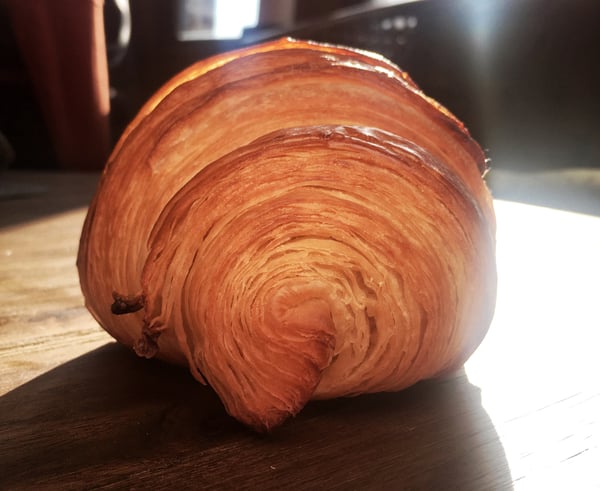 In a world of very wonderful bread products, perhaps none are as sublime when made well as the croissant. A shatteringly crisp golden burnished crust mere fractions of a millimeter thick enclosing a pillowy soft interior with the tiniest hint of satisfying chew, and the entire thing redolent with the aroma of excellent butter. This is a croissant at its best, and when it is at its best there are not many gluten based delicacies that can compare. I’ll stop short of saying that a croissant is a better bread product than other high coefficient-of-deliciousness breads, but if I ever need to choose just one to eat for the rest of my life, I already know which one I’m choosing (the croissant).
In a world of very wonderful bread products, perhaps none are as sublime when made well as the croissant. A shatteringly crisp golden burnished crust mere fractions of a millimeter thick enclosing a pillowy soft interior with the tiniest hint of satisfying chew, and the entire thing redolent with the aroma of excellent butter. This is a croissant at its best, and when it is at its best there are not many gluten based delicacies that can compare. I’ll stop short of saying that a croissant is a better bread product than other high coefficient-of-deliciousness breads, but if I ever need to choose just one to eat for the rest of my life, I already know which one I’m choosing (the croissant).
Woe be unto me, then, to discover on a recent trip to France that near all of the croissants I’ve had up to that point have fallen short of the basic standard of French viennoiserie that can be found at nearly any boulangerie even in a small French village. One reason for this is obvious the moment the flavor of a good croissant registers on your tastebuds: butter quality. As a cook who lives and works in the U.S. I got pretty tired of hearing that the butter in France is just better than American butter. I always took this to mean that even bad French butter is better than the best American butter. While this is not exactly true, what does seem to be true is that the average French butter, especially the average butter used in a French croissant is just much more flavorful than the butter used by most American bakeries. And because so much of a croissants flavor comes from the butter, if you use a bland butter you’re going to end up with a bland croissant.
But to me the butter is not the main culprit bringing down the standards of so much American (and, I have to assume, other countries’s) viennoiserie. It’s texture. You see, a French croissant has one quality above perhaps any other. It is soft. I have eaten croissants at a number of bakeries in the U.S. that I would consider extremely good (the bakeries, not necessarily the croissants). And while most of them are not exactly what I would call tough, they definitely do not adhere to the standard of softness upheld at literally every French bakery I tried. I think there is one reason for this above all others, and that is aesthetics.
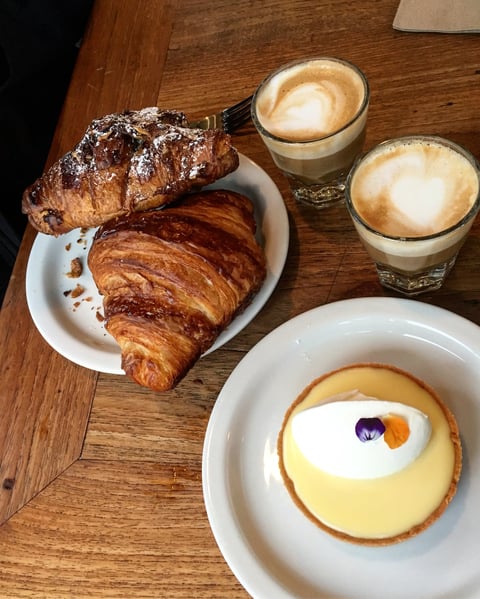
A classic modern croissant from Tartine in San Francisco. Delicious? Yes Soft? No
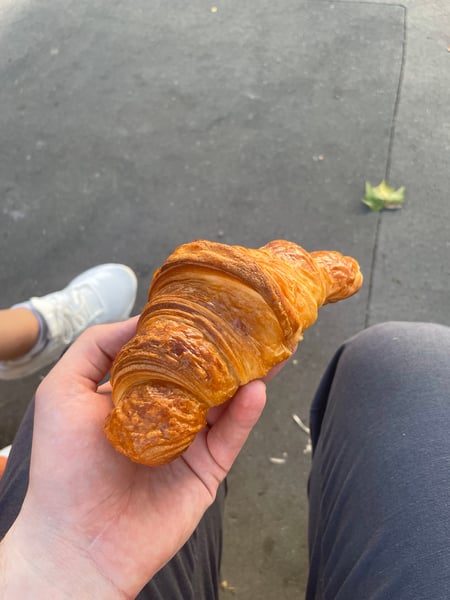 A classic French croissant from Boulangerie Utopie in Paris. Still a good shape, though not as picturesque as the Tartine example. Yet a flavor and texture that I would personally say is well superior.
A classic French croissant from Boulangerie Utopie in Paris. Still a good shape, though not as picturesque as the Tartine example. Yet a flavor and texture that I would personally say is well superior.
In the age of Instagram and TikTok, it's more important than ever for a bakery to have products that look good. As an online collective we seem to have agreed that what makes a croissant look good is a sharp and well defined shape; distinct, clearly visible lamination or separation of layer; and a perfect honeycomb spiral interior cross-section. I myself find these attributes very appealing in the look of a croissant, but they can come at a price. The easiest way to achieve this look is to make a very strong dough out of high protein flour. This, in turn, gives rise (LOL) to a croissant that is chewier than it is soft, and, in the worst cases, downright tough.
I will admit that I had been taken in by this point of view myself. Here I am looking disappointed that my first ever real go at making croissants had not resulted in perfect, clean, ziggurat-like steps with sharp edges and clearly visible layer separation.
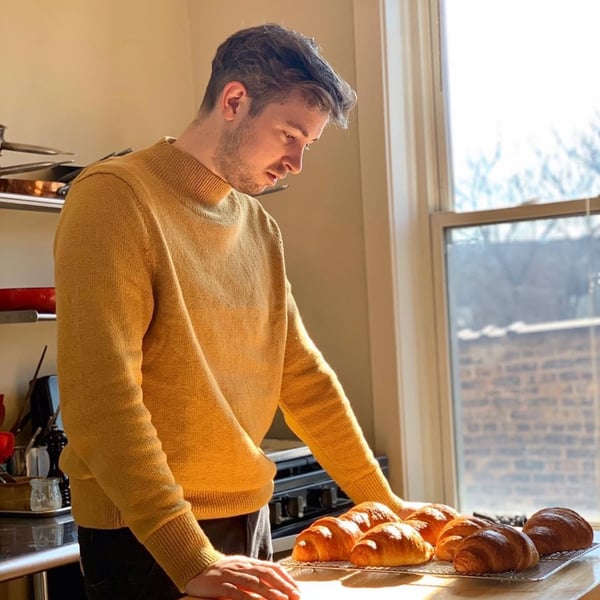
And I would continue to chase this aesthetic ideal for years after.
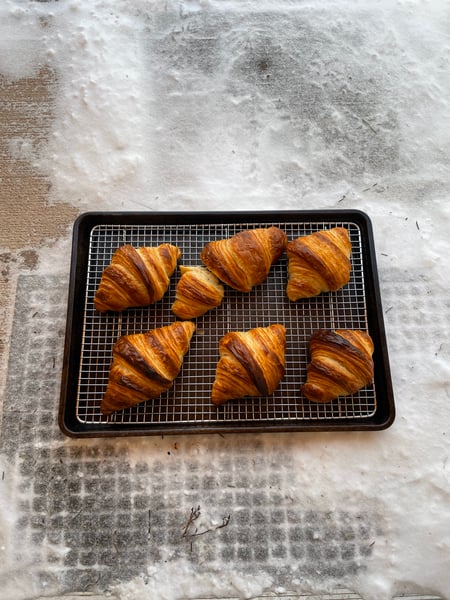
A batch of croissants I made two and a half years after the previous picture. Exhibiting many of the attributes we have mentioned. Sharp steps, distinct lamination, and chewiness
It wasn’t until I visited Montreal for the first time that I was exposed to what a true French croissant was like at a bakery called Kouign Amann.
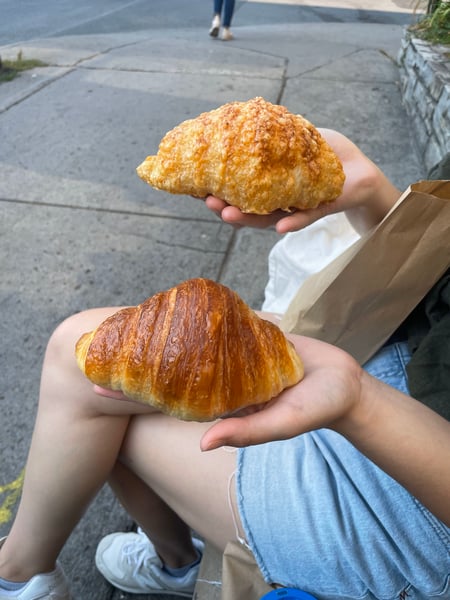
Here we can see a croissant that cares nothing for our modern aesthetic definitions of what a good croissant should look like, yet it was perhaps the best croissant I had ever had up until that point. This is not to say that croissants that look incredibly Instagram ready are necessarily lesser than, or that they can’t be as good as a typical French croissant. Here is an incredibly photogenic piece of viennoiserie from a bakery, also in Montreal, called Rhubarb.
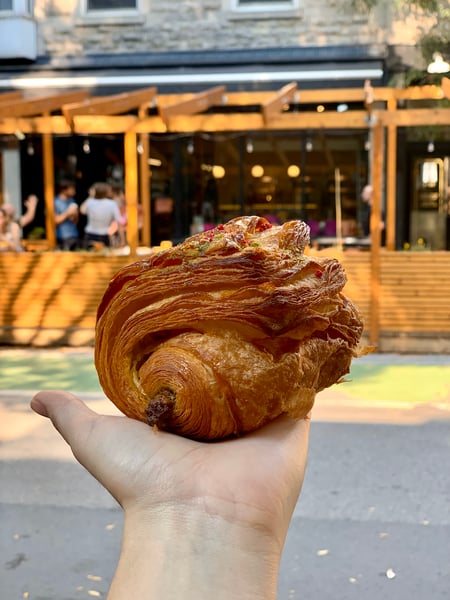
While this pastry was not as pillowy as the one from Kouign Amann, it was still excellent. There is certainly something to be said for the idea that this type of croissant is a style all its own; distinct from, yet equal to the classic French style. Indeed I think this is the case when truly well executed. However this is not the typical outcome of chasing this look. The typical outcome is something that has looks that promise much more than what the actual eating experience delivers.
All of this to say, while our culture is definitely preoccupied with how things look above basically all else, it is important not to lose sight of the fact that looks are meant to be a signal of a good overall experience. We’ve all seen from behind-the-scenes footage of commercial food styling techniques that what it takes to make food look good, does not always equate to a similarly elevated eating experience. In fact, they are often at odds. When it comes to croissants in particular we ought to be seeking out the best complete eating experiences we can and holding them up is the ideal rather than finding exceptional looking pastries and assuming this indicates a well made product.
If all this talk of French pastry has you craving some delicious French cuisine to go along with it, check out our Culinary Adventure: Trip to Southern France class coming up on Thursday, August 17 at 6pm at Lincoln Square. You'll learn how to make and enjoy:
- Mussels Steamed with White Wine, Shallots and Parsley
- Roasted Chicken Thighs with Lemon and Herbs
- Ratatouille Niçoise
- Buttery Madeleines with Powdered Sugar
Bon Appetit!

